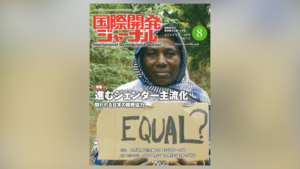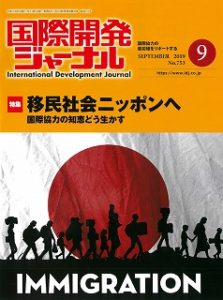Gender Mainstreaming- A New Development Agenda Challenge for Japanese ODA
IDJ ENGLISH
『International Development Journal』 2019 August edition
Gender and Development Special
Gender perspective on infrastructure
In June, 2019, the G20 Principles on Quality Infrastructure Investment were approved at a Meeting of the G20 Finance Ministers and Central Bank Governors in Fukuoka. It stipulated that “particular consideration should be given to methods of promoting women’s empowerment through opportunities created by infrastructure investment.”
Until now, the interrelationship between infrastructure investment and women’s empowerment has not been discussed very much. However, with growing understanding in recent years that women’s empowerment is driving economic growth, the importance of a gender perspective in quality infrastructure investment has been recognized. Ms Atsuko Kamei, the Director of the office for Gender Equality and Poverty Reduction, Infrastructure and Peacebuilding Department at Japan International Cooperation Agency (JICA), said, “We have entered a new era.”
In response to these changes in development trends, donors and international organizations in each country are promoting organizational reform and gender mainstreaming in projects. The Inter-American Development Bank (IDB) also says that it has developed a gender action plan for all projects. Gender is no longer one of the “considerations” of the project, but an important factor that must be taken into account.
Numerical targets in JICA’s mid-term plan
Although JICA started its move toward gender mainstreaming about 20 years ago, it has not progressed as far as expected. However, in the mid-term plan for FY2017-2021, a numerical target was set to increase the ratio of projects that incorporate a certain amount of gender-related measures to at least 40% on a value basis. “The fact that the numerical targets were set in the medium-term plan indicates that the organization has a strong awareness of the issues,” said Kamei.
The Office for Promotion of Gender Equality and Poverty Reduction checks projects under all schemes, such as ODA loans, technical cooperation and private partnerships, in addition to implementing projects mainly for gender equality. It also provides feedback and advice based on gender perspectives. However, they don’t have any enforcement powers. “Even if we say that construction companies should hire a certain number of women when doing construction work, they have their own resource issues, so we leave it up to the discretion of department in charge,” said Kamei.
Under these circumstances, projects incorporating a gender perspective are gradually increasing, mainly in agriculture and disaster prevention. Ms Kamei said, “I want to focus on gender mainstreaming in the infrastructure field for the time being based on the Japanese government policy of promoting high quality infrastructure.” She gives the example of the Delhi Metro which has a variety of initiatives including installing women-only carriages, monitoring cameras and employing female crews and conductors. Similar projects are being considered in Dhaka, Bangladesh. Also, within the ODA loan project currently underway in Sri Lanka to develop an LRT system for urban transport systems. Preparation of gender action plans and on-site gender training are being promoted.
Women as a vehicle for change
In order to promote gender mainstreaming, it is necessary to clarify local gender issues and incorporate activities that contribute to solving these issues into the plan from the project formation stage. At such times, there is a need to determine whether there are any influences in various processes, such as identifying needs and grasping / analyzing the status of achievements / impacts, based on the gender norms unconsciously held by the government officials and implementers of the partner country. Care must also be taken to ensure that projects are planned and implemented more fairly.
However, one thing that tends to fall into such situations is thinking, “We should consider some women as beneficiaries.” Instead, gender equality can be seen by treating women as vehicles for change and aiming to develop skills and change to social norms so that women can demonstrate their abilities. It is difficult to make such changes dramatically in countries such as the Islamic states where traditional role norms are rooted. However, as in the case of Egypt’s “Improving Small-scale Farmers’Market-Oriented Agriculture Project (ISMAP)”, a change of the relationship between men and women can be created.
To achieve such gender main streaming of all projects, Ms Kamei believes that it is desirable for each business unit to take the initiative. However, there are many issues to be addressed, such as improving the gender literacy of JICA, as a whole, as well as expanding the Gender Equality and Poverty Reduction Promotion Office from the current four-person system.
Development consultants’ perspectives
Development consultants are also moving, with the Engineering and Consulting Firms Association (ECFA) conducting gender training with JICA. However, many consultants are worried that they don’t know what to do. “It is difficult to implement a project with consideration for gender without budgetary measures or specific descriptions in the specifications and instructions.”
In addition, there are voices calling for JICA staff to increase their gender awareness and knowledge and to expand their gender experts. Until now, there have been few projects in Japan’s ODA that gender experts can participate in, even if they are studying gender in particular, and the brain drain of gender experts often occurs. How do you develop and secure human resources in the future? That may need to be considered by JICA and the development business community, as a whole. In this sense, IC Net Co., Ltd. is working to strengthen its employees and has received orders for various gender projects, not only from Japan’s ODA but also from the World Bank and Japan’s ministries.
In promoting JICA’s gender mainstreaming, there are examples of projects that have not been proposed as gender projects but that have been successful as part of such projects. It is also necessary to make these outcomes more visible. If gender-specific statistics are collected and analyzed at the time of evaluation for all activities, such as the proportion of men and women who participate in the training, even those who are not gender-aware will become so.
Included into SDGs
While promoting gender mainstreaming in various areas, it is important to tackle issues arising from gender inequality. Although JICA promotes gender mainstreaming, the proportion of projects focusing on gender equality has not increased much. Compared with other donors, the OECD/DAC countries average is 3.8% and Japan is only 0.6%.
In addition to treating it as a cross-cutting issue, it is necessary to support gender issues as one of the development issues as well as in infrastructure and agriculture. In the Sustainable Development Goals (SDGs), gender equality was set out in Goal 5. In the previous discussion, there were some negative opinions, “it is not necessary to set Goal 5 because all the goals should be gender perspectives.” But gender interests and commitments around the world will change significantly, depending on whether it is included into the 17 goals.
However, none of these SDGs mention LGBT (one of the words for sexual minority, acronym for lesbian, gay, bisexual and transgender). In the world, as there are lawful countries for same-sex marriages and, on the other hand, countries that outlaw same-sex relationships, so it could not be included in the common goal.
If Japan’s development cooperation is concerned about gender, it may be also necessary to look at LGBT in the future. As the development trend moves toward gender mainstreaming, it is time for Japan to take a step in this wave as a new challenge. (Saki Kawata)
*****以下、日本語原文*****
ジェンダー主流化:日本の援助の新たな強みに 本腰入れる時期
インフラにもジェンダー視点
今年6月、福岡で開かれた20か国財務大臣・中央銀行総裁会議で「質の高いインフラ投資に関するG20原則」が承認された。その中には、「インフラ投資により創出される機会を通じて、女性のエンパワーメントを如何に促進するかを、特に考慮すべき」と明記された。
インフラ投資と女性のエンパワーメント。これまで相互の関連性はあまりないと思われてきた。だが近年、女性のエンパワーメントは経済成長を牽引するという理解が広まる中、質の高いインフラ投資においてもジェンダー視点を入れることの重要性が認識されたのである。「一つの新しい時代に入った」と、国際協力機構(JICA)社会基盤・平和構築部 ジェンダー平等・貧困削減推進室の亀井温子室長は感じている。
こうした開発潮流の変化を受けて、各国のドナーや国際機関は組織改革や案件におけるジェンダー主流化を進めている。(ADB、DFIDの取り組みは22~23ページ参照)米州開発銀行(IDB)も、全ての案件においてジェンダーアクションプランを作っているという。ジェンダーはもはや、案件における「配慮事項」の一つではなく、必ず取り込むべき重要な要素となっているのだ。
JICA中期計画に数値目標
国際協力機構(JICA)でも、20年くらい前からジェンダー主流化に向けた動きは始まっていたが、思うようには進んでいなかった。しかし2017~2021年度の中期計画で、ジェンダーに関する取り組みが一定程度取り入れられている案件の比率を金額ベースで40%以上にするという数値目標が示された。亀井室長は、「中期計画で数値目標が設けられたということは、組織としてかなり問題意識を持っていることの表れ」と語る。
ジェンダー平等・貧困削減推進室は、ジェンダー平等を主たる目的とした案件の実施に加え、円借款や技術協力、民間連携などあらゆるスキームの案件をチェックし、ジェンダーの視点に基づいたフィードバックや助言もしている。ただ、それらに強制力はない。「建設工事をやる時に女性を一定程度雇用しなさいと言っても、リソースなどの問題もあるのでどこまで対応するかは事業部の裁量に任せている」(亀井室長)と言う。
そうした中で、ジェンダー視点を取り入れた案件は農業や防災などを中心に徐々に増えている。亀井室長は、「当面はインフラ分野でのジェンダー主流化を重点的にやりたい。日本政府からの期待も高い」と語り、事例としてインドのデリーメトロ事業を挙げた。デリーメトロには女性専用車両や監視カメラを設けたり、女性乗務員や車掌を採用したりとさまざまな取り組みが盛り込まれた。今後、バングラデシュ・ダッカでも類似の案件が検討されているという。また、現在スリランカで実施されている都市交通システムのLRTシステムを整備する円借款事業でも、ジェンダーアクションプランの作成や現地でのジェンダー研修の実施が進められている。
女性を変革の主体と捉える
ジェンダー主流化を進める上では、現地のジェンダー課題を明らかにし、その課題解決に資するような活動を案件形成の段階から計画に盛り込んでいく必要がある。その際には、相手国政府関係者や実施者が無意識的に持つジェンダー規範により、ニーズの特定や成果・インパクトの発現状況の把握・分析などさまざまな過程で何らかの影響が出ていないかを見極め、より公正にプロジェクトが計画・実施されるよう気を配ることも求められる。
だが、そうした時に陥りやすいのが、「受益者に女性を少し含めて配慮しておけばいい」と考えてしまうことだ。そうではなく、女性も変革の主体として捉え、彼女たちがその能力を発揮できるよう能力開発や社会規範の変化を目指すことがジェンダー平等につながるのだ。伝統的な役割規範が根付いているイスラム圏の国などでは、そうした変革を劇的に起こすのは難しい。だが、エジプトの「小規模農家の市場志向型農業改善プロジェクト」(ISMAP)の事例のように、工夫すればそうした男女の関係性に変化を生み出すこともできる。
こうしたジェンダー主流化を全ての案件で実現するには、事業部門それぞれが主体的に進められるようにすることが望ましいと、亀井室長は考えている。だがそのためにはJICA全体のジェンダー・リテラシーを向上させ、ジェンダー平等・貧困削減推進室も現在の4人体制から拡充するなど、やるべき課題は多いという。
開発コンサルタントの視点
開発コンサルタントも、(一社)海外コンサルタンツ協会(ECFA)がJICAとジェンダー研修を実施するなど、動いている。
だが、「具体的に何をすればいいか分からない」と悩むコンサルタントも少なくない。「予算措置や仕様書・指示書への具体的な記述なしに、ジェンダーに配慮してプロジェクトを実施するよう言われても難しい」という声も聞いた。
このほか、JICA職員のジェンダーに関する意識や知見の向上、ジェンダー専門家の拡充を求める声も出ている。日本のODAではこれまで、ジェンダーを専門に勉強していても参加できる案件は少なく、ジェンダーを専門とする人材は外に出てしまうことが多かった。今後は人材をどう育成・確保するか。そうしたこともJICAや開発業界全体で考えていく必要があるかもしれない。
そうした意味では、アイ・シー・ネット(株)は社員の能力強化を進め、日本のODAだけでなく、世界銀行や日本の省庁などさまざまなジェンダー案件を受注しており、興味深い。
このほか、JICAのジェンダー主流化を促す上で、「ジェンダー案件と打ち出していないものの中にも、案件の一部として取り組んで成果を出した事例はある。そうした成果をもっと可視化することも必要」「研修参加者の男女割合など、すべての活動において男女別の統計をとり評価時に分析するようにすれば、ジェンダー意識がない人でも気づきがあるし、ジェンダー意識のある人はそのデータを活用して活動に生かすことができる」という指摘も出ている。
主眼に置いた支援も
さまざまな分野でジェンダー主流化を進める一方、忘れてはならないのはジェンダー不平等から生まれる問題に正面切って取り組む支援だ。JICAはジェンダー主流化を進める一方、ジェンダー平等を主眼に置く案件の割合はあまり増えていない。案件全体における比率を他のドナーと比べても、DAC平均は3.8%、日本は0.6%だ。
横断的な課題として扱うだけでなく、インフラや農業と同じように開発課題の一つとしてジェンダー支援に取り組む。持続可能な開発目標(SDGs)では、そうした思いから目標5でジェンダー平等が掲げられた。その前の議論では、「全ての目標でジェンダー視点を入れればいいから目標5を入れる必要はない」と反対する声もあった。だが、13の目標に入るか否かでは、世界のジェンダーに対する関心や取り組みは大きく変わる。「取り残される女性を出さないためにも必要だ」と主張した末の結果だという。
ただ、そうしたSDGsでもLGBT(レズビアン、ゲイ、バイセクシャル、トランスジェンダーの頭文字をとった性的少数者を表す言葉の一つ)についてはどこにも述べられていない。世界では同性婚が合法の国から、同性間の性行為に死刑を科す国まであり、共通目標に含むことができなかったからだ。しかし、日本の開発協力がジェンダーについて関心を寄せていくのであれば、今後はLGBTについても目を向けていく必要はあるかもしれない。
開発の潮流がジェンダーへと向かっていく中、日本は新たな強みとして本腰を入れてこの波に乗っていく時ではないだろうか。
本誌編集委員:川田 沙姫
『国際開発ジャーナル』 2019年8月号掲載記事



